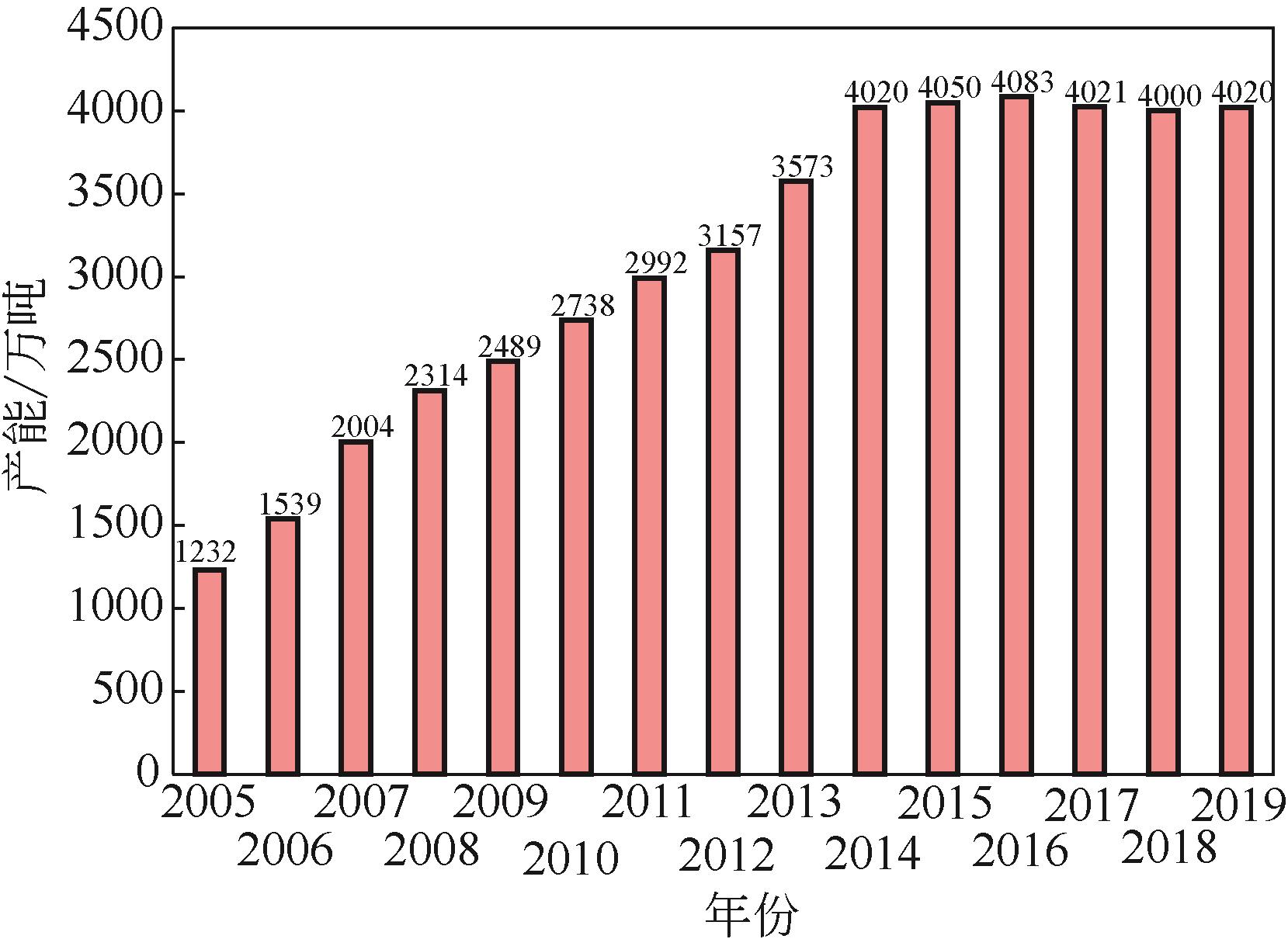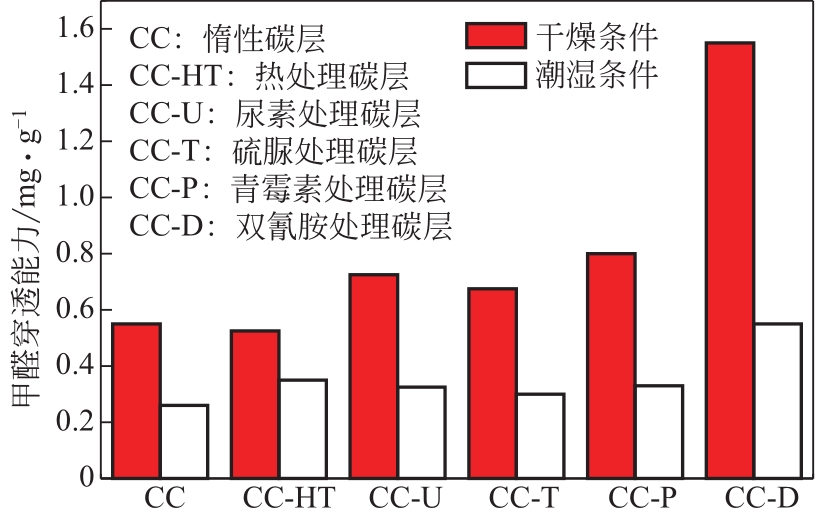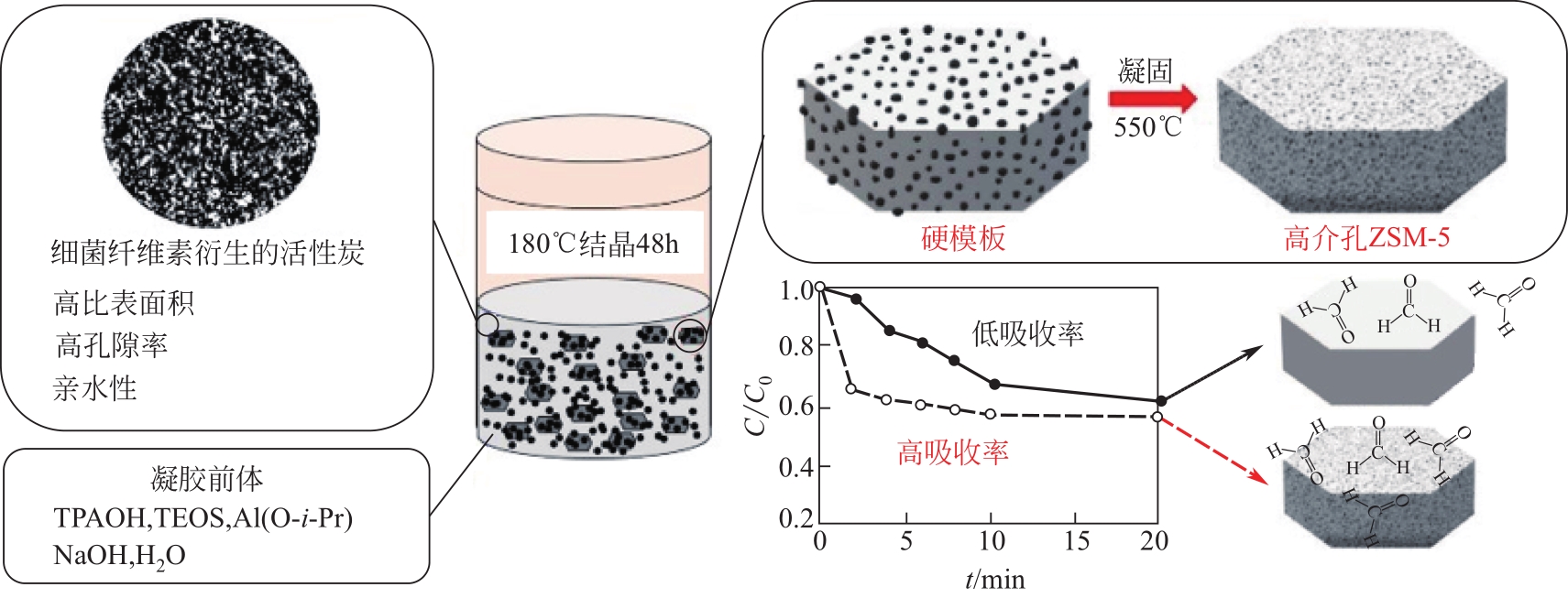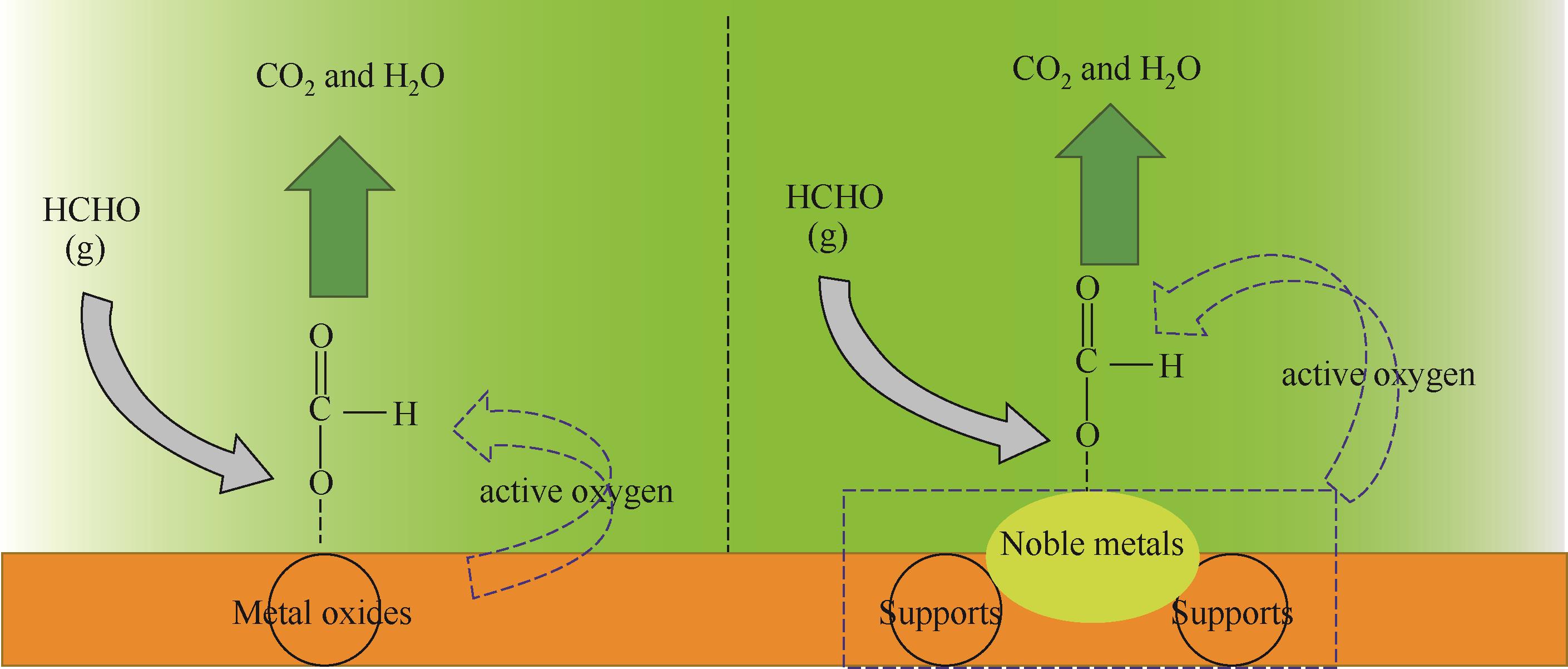化工进展 ›› 2021, Vol. 40 ›› Issue (12): 6876-6888.DOI: 10.16085/j.issn.1000-6613.2021-0013
气体中微量甲醛的脱除研究进展
孙曼颖( ), 姜伟丽(
), 姜伟丽( ), 周广林, 周红军, 李芹, 李想
), 周广林, 周红军, 李芹, 李想
- 中国石油大学(北京)新能源与材料学院,北京 102249
-
收稿日期:2021-01-05修回日期:2021-03-18出版日期:2021-12-05发布日期:2021-12-21 -
通讯作者:姜伟丽 -
作者简介:孙曼颖(1995—),女,硕士研究生,研究方向为气体净化。E-mail:13183338126@163.com 。 -
基金资助:中国石油天然气集团有限公司-中国石油大学(北京)战略合作科技专项(ZLZX2020-04)
Research progress in the removal of trace formaldehyde in gas
SUN Manying( ), JIANG Weili(
), JIANG Weili( ), ZHOU Guanglin, ZHOU Hongjun, LI Qin, LI Xiang
), ZHOU Guanglin, ZHOU Hongjun, LI Qin, LI Xiang
- Institute of New Energy and Materials,China University of Petroleum,Beijing 102249,China
-
Received:2021-01-05Revised:2021-03-18Online:2021-12-05Published:2021-12-21 -
Contact:JIANG Weili
摘要:
主要阐述了去除甲醛气体的常用材料(吸附材料、催化氧化材料、光催化降解材料和生物技术材料)的研究进展,文中指出碳基材料、分子筛、有机金属骨架常常被用作吸附挥发性有机气体,它们具备丰富的孔道结构和较大的比表面积,碳基材料和分子筛表面存在大量丰富的基团能够有效地增大甲醛的吸附容量,提高甲醛的吸附效率;有机金属骨架表面的金属与甲醛结合成键,有效提高材料的化学吸附;以金属氧化物为载体的材料常被用作催化氧化甲醛分子,将甲醛分子转化为无毒性的二氧化碳和水;半导体材料TiO2常被用作光催化降解材料去除甲醛;除此之外还有一些利用生物技术来去除甲醛气体。本文对比了不同材料去除甲醛的优劣性,对不同的去除材料改性研究进行了归纳总结。
中图分类号:
引用本文
孙曼颖, 姜伟丽, 周广林, 周红军, 李芹, 李想. 气体中微量甲醛的脱除研究进展[J]. 化工进展, 2021, 40(12): 6876-6888.
SUN Manying, JIANG Weili, ZHOU Guanglin, ZHOU Hongjun, LI Qin, LI Xiang. Research progress in the removal of trace formaldehyde in gas[J]. Chemical Industry and Engineering Progress, 2021, 40(12): 6876-6888.
| 材料 | 去甲醛原理 | 影响因素 | 优点 | 缺点 |
|---|---|---|---|---|
| 吸附材料 | 利用吸附剂与被吸附物质之间形成的范德华力或者化学吸附实现被吸附物质的选择性去除 | 材料孔道结构、比表面积、湿度、温度等 | 成本低、不引入新杂质 | 吸附容量有限 |
| 催化氧化材料 | 金属或金属氧化物催化甲醛发生氧化还原反应,使甲醛转化为CO2和H2O | 金属种类、反应温度、制备方法等 | 去除效率高 | 引入新杂质 |
| 光催化材料 | 在紫外光的作用下,发生氧化-还原反应以降解甲醛 | 紫外线强度、金属负载量、负载金属种类等 | 新型节能 | 成本高 |
| 生物技术 | 通过植物修复、微生物去除 | 植物种类、甲醛浓度等 | 环保、具有经济效益 | 周期较长 |
表1 不同甲醛去除方法对比
| 材料 | 去甲醛原理 | 影响因素 | 优点 | 缺点 |
|---|---|---|---|---|
| 吸附材料 | 利用吸附剂与被吸附物质之间形成的范德华力或者化学吸附实现被吸附物质的选择性去除 | 材料孔道结构、比表面积、湿度、温度等 | 成本低、不引入新杂质 | 吸附容量有限 |
| 催化氧化材料 | 金属或金属氧化物催化甲醛发生氧化还原反应,使甲醛转化为CO2和H2O | 金属种类、反应温度、制备方法等 | 去除效率高 | 引入新杂质 |
| 光催化材料 | 在紫外光的作用下,发生氧化-还原反应以降解甲醛 | 紫外线强度、金属负载量、负载金属种类等 | 新型节能 | 成本高 |
| 生物技术 | 通过植物修复、微生物去除 | 植物种类、甲醛浓度等 | 环保、具有经济效益 | 周期较长 |
| 1 | 冯晓波. 甲醛市场现状及发展趋势刍议[J]. 中氮肥, 2017(6): 51-54. |
| FENG X B. The current situation and development trend of formaldehyde market[J]. Nitrogenous Fertilizer Progress, 2017(6): 51-54. | |
| 2 | 资讯部. 化工大数据 甲醛[J]. 广州化工, 2019, 47: 13-14. |
| Department Information. Chemical big data[J]. Guangzhou Chemical, 2019, 47: 13-14. | |
| 3 | SONGUR A, OZEN O A, SARSILMAZ M. Reviews of environmental contamination and toxicology: the toxic effects of formaldehyde on the nervous system[M]. New York: Springer, 2009: 105-118. |
| 4 | 资讯部. 化工大数据 图说国内甲醛市场[J]. 广州化工, 2019, 47 (13): 13-14. |
| Department Information. Big data of chemical industry, domestic formaldehyde market[J]. Guangzhou Chemical Industry, 2019, 47(13): 13-14. | |
| 5 | TASBIHI M, BENDYNA J K, NOTTEN P H L, et al. A short review on photocatalytic degradation of formaldehyde[J]. Journal of Nanoscience and Nanotechnology, 2015, 15(9): 6386-6396. |
| 6 | SHAO Y H, WANG Y X, ZHAO R, et al. Biotechnology progress for removal of indoor gaseous formaldehyde[J]. Applied Microbiology and Biotechnology, 2020,104: 3715-3727. |
| 7 | WANG B F, XU X X, XU W C, et al. The mechanism of non-thermal plasma catalysis on volatile organic compounds removal[J]. Catalysis Surveys from Asia, 2018, 22 (2): 73-94. |
| 8 | PENG J X, WANG S D. Performance and characterization of supported metal catalysts for complete oxidation of formaldehyde at low temperatures[J]. Applied Catalysis B: Environmental, 2007, 73 (3/4): 282-291. |
| 9 | BERNABE D P, HERRERA R A S, DOMA B T, et al. Adsorption of low concentration formaldehyde in air using ethylene-diamine-modified diatomaceous earth[J]. Aerosol and Air Quality Research, 2015, 15(4): 1652-1661. |
| 10 | SURESH S, BANDOSZ T J. Removal of formaldehyde on carbon -based materials: a review of the recent approaches and findings[J]. Carbon, 2018, 137: 207-221. |
| 11 | LEE K J, MIYAWAKI J, SHIRATORI N, et al. Toward an effective adsorbent for polar pollutants: formaldehyde adsorption by activated carbon[J]. Journal of Hazardous Materials, 2013, 260: 82-88. |
| 12 | 尤名扬. 活性炭在吸附室内甲醛上的应用[J]. 科学技术创新, 2019(32): 142-143. |
| YOU M Y. The application of activated carbon in adsorption of indoor formaldehyde[J]. Scientific and Technological Innovation, 2019(32): 142-143. | |
| 13 | DE FALCO G, LI W L, CIMINO S, et al. Role of sulfur and nitrogen surface groups in adsorption of formaldehyde on nanoporous carbons[J]. Carbon, 2018, 138: 283-291. |
| 14 | 蔡林恒, 李湘洲, 刘艳新, 等. 改性竹炭对甲醛的吸附性能研究[J]. 中南林业科技大学学报, 2016, 36(10): 119-123. |
| CAI L H, LI X Z, LIU Y X, et al. Study on adsorption properties of modified bamboo charcoal for formaldehyde[J]. Journal of Central South University of Forestry & Technology, 2016, 36(10): 119-123. | |
| 15 | HU S C, CHEN Y C, LIN X Z, et al. Characterization and adsorption capacity of potassium permanganate used to modify activated carbon filter media for indoor formaldehyde removal[J]. Environmental Science and Pollution Research, 2018, 25(28): 28525-28545. |
| 16 | 吴秋雨, 张涛, 董岁明, 等. 竹炭与猪骨炭对甲醛吸附性能的研究[J]. 应用化工, 2018, 47(8):1577-1580. |
| WU Q Y, ZHANG T, DONG S M, et al. Adsorption of formaldehyde on bamboo charcoal and pig bone charcoal[J]. Applied Chemical Industry, 2018, 47(8): 1577-1580. | |
| 17 | DE FALCO G, BARCZAK M, MONTAGNARO F, et al. A new generation of surface active carbon textiles as reactive adsorbents of indoor formaldehyde[J]. ACS Applied Materials & Interfaces, 2018, 10(9): 8066-8076. |
| 18 | BAUR G B, SPRING J, KIWI-MINSKER L. Amine functionalized activated carbon fibers as effective structured adsorbents for formaldehyde removal[J]. Adsorption, 2018, 24(8): 725-732. |
| 19 | RYU D Y, SHIMOHARA T, NAKABAYASHI K, et al. Urea/nitric acid co-impregnated pitch-based activated carbon fiber for the effective removal of formaldehyde[J]. Journal of Industrial and Engineering Chemistry, 2019, 80: 98-105. |
| 20 | ZHANG D D, ZHANG M X, DING F, et al. Efficient removal of formaldehyde by polyethyleneimine modified activated carbon in a fixed bed[J]. Environmental Science and Pollution Research, 2020, 27(15): 18109-18116. |
| 21 | 谢佳平, 牟虹蓉, 陶飞, 等. 尿素修饰的活性炭吸附甲醛研究[J]. 山东化工, 2020, 49(8): 10-12. |
| XIE J P, MOU H R, TAO F, et al. Adsorption of formaldehyde on activated carbon modified with urea[J]. Shandong Chemical Industry, 2020, 49(8): 10-12. | |
| 22 | 王亮才, 刘沙沙, 马欢欢, 等. 活性炭负载MnO2及其对甲醛的吸附[J]. 应用化工, 2020, 49(5): 1110-1116, 1120. |
| WANG L C, LIU S S, MA H H, et al. Activated carbon loaded MnO2 and its adsorption of formaldehyde[J]. Applied Chemical Industry, 2020, 49(5): 1110-1116, 1120. | |
| 23 | WOOD C D, TAN B E, TREWIN A, et al. Hydrogen storage in microporous hypercrosslinked organic polymer networks[J]. Chemistry of Materials, 2007, 19(8): 2034-2048. |
| 24 | LIU G H, WANG J L, ZHU Y F, et al. Application of multiwalled carbon nanotubes as a solid-phase extraction sorbent for chlorobenzenes[J]. Analytical Letters, 2004, 37(14): 3085-3104. |
| 25 | RAO G P, LU C, SU F S. Sorption of divalent metal ions from aqueous solution by carbon nanotubes: a review[J]. Separation and Purification Technology, 2007, 58(1): 224-231. |
| 26 | PYRZYNSKA K, STAFIEJ A, BIESAGA M. Sorption behavior of acidic herbicides on carbon nanotubes[J]. Microchimica Acta, 2007, 159(3/4): 293-298. |
| 27 | LI H, ZHENG N, LIANG N, et al. Adsorption mechanism of different organic chemicals on fluorinated carbon nanotubes[J]. Chemosphere, 2016, 154: 258-265. |
| 28 | YANG S, ZHU Z X, WEI F, et al. Enhancement of formaldehyde removal by activated carbon fiber viain situ growth of carbon nanotubes[J]. Building and Environment, 2017, 126: 27-33. |
| 29 | CHEN D, YUAN Y J. Formaldehyde adsorption on carbon nanotubes fragment by density functional theory[J]. International Journal of Modern Physics B, 2017, 31(16/17/18/19): 1744074. |
| 30 | ZHOU X, ZHAO C H, CHEN C T, et al. DFT study on adsorption of formaldehyde on pure, Pd-doped, Si-doped single-walled carbon nanotube[J]. Applied Surface Science, 2020, 525: 146595. |
| 31 | TAN H C, CHEN D Y, LI N J, et al. Platinum-supported zirconia nanotube arrays supported on graphene aerogels modified with metal-organic frameworks: adsorption and oxidation of formaldehyde at room temperature[J]. Chemistry, 2019, 25(72): 16718-16724. |
| 32 | LIU Z J, ZHANG D W, WEI T H, et al. Adsorption characteristics of formaldehyde on nitrogen doped graphene-based single atom adsorbents: a DFT study[J]. Applied Surface Science, 2019, 493: 1260-1267. |
| 33 | 吴利瑞, 张蓝心, 于飞, 等. 氨基化碳纳米管/石墨烯气凝胶对甲醛吸附研究[J]. 中国环境科学, 2015, 35(11): 3251-3256. |
| WU L R, ZHANG L X, YU F, et al. Facile composite of amino carbon nanotubes/graphene: preparation and adsorption for gaseous formaldehyde[J]. China Environmental Science, 2015, 35(11): 3251-3256. | |
| 34 | 刘志明, 吴鹏. 壳聚糖/纤维素气凝胶球的制备及其甲醛吸附性能[J]. 林产化学与工业, 2017, 37(1): 27-35. |
| LIU Z M, WU P. Preparation of chitosan/cellulose aerogel beads and its formaldehyde gas adsorption performance[J]. Chemistry and Industry of Forest Products, 2017, 37(1): 27-35. | |
| 35 | REN L P, XIAO X F, CHEN Y L, et al. Preparation of ZIF-8/natural plant fiber composites via biomimetic mineralization for highly efficient removal of formaldehyde[J]. ChemistrySelect, 2019, 4(42): 12294-12303. |
| 36 | KHAMKEAW A, PHISALAPHONG M, JONGSOMJIT B, et al. Synthesis of mesoporous MFI zeolite via bacterial cellulose-derived carbon templating for fast adsorption of formaldehyde[J]. Journal of Hazardous Materials, 2020, 384: 121161. |
| 37 | HIGGINS J B, LAPIERRE R B, SCHLENKER J L, et al. The framework topology of zeolite beta[J]. Zeolites, 1988, 8(6): 446-452. |
| 38 | 李慧芳, 徐海, 赵勤, 等. 几种分子筛对甲醛气体吸附性能的研究[J]. 硅酸盐通报, 2014, 33(1): 122-126. |
| LI Huifang, XU Hai, ZHAO Qin, et al. Adsorption performance of formaldehyde on molecular sieve[J]. Bulletin of the Chinese Ceramic Society, 2014, 33(1): 122-126. | |
| 39 | REN L P, YU Y, YANG Y, et al. Efficient removal of formaldehyde with ZIF-8 growth on TiO2-coated activated carbon fiber felts prepared via atomic layer deposition[J]. Journal of Materials Science, 2020, 55(8): 3167-3180. |
| 40 | BELLAT J P, WEBER G, BEZVERKHYY I, et al. Selective adsorption of formaldehyde and water vapors in NaY and NaX zeolites[J]. Microporous and Mesoporous Materials, 2019, 288: 109563. |
| 41 | LI Y W, YANG R T. Gas adsorption and storage in metal-organic framework MOF-177[J]. Langmuir, 2007, 23(26): 12937-12944. |
| 42 | WANG L, LIANG X Y, CHANG Z Y, et al. Effective formaldehyde capture by green cyclodextrin-based metal-organic framework[J]. ACS Applied Materials & Interfaces, 2018, 10(1): 42-46. |
| 43 | FU C M, CHEN T, XIAO T L, et al. Formaldehyde gas adsorption in high-capacity silver-nanoparticle-loaded ZIF-8 and UiO-66 frameworks[J]. ChemistrySelect, 2020, 5(20): 5987-5992. |
| 44 | DUTTA T, KIM K H, BROWN R J C, et al. Metal-organic framework and Tenax-TA as optimal sorbent mixture for concurrent GC-MS analysis of C1 to C5 carbonyl compounds[J]. Scientific Reports, 2018, 8: 5033. |
| 45 | BIAN Y, WANG R T, WANG S J, et al. Metal-organic framework-based nanofiber filters for effective indoor air quality control[J]. Journal of Materials Chemistry A, 2018, 6(32): 15807-15814. |
| 46 | WANG Z, WANG W, JIANG D, et al. Diamine-appended metal-organic frameworks: enhanced formaldehyde-vapor adsorption capacity, superior recyclability and water resistibility[J]. Dalton Transactions, 2016, 45(28): 11306-11311. |
| 47 | QUIROZ J, GIRAUDON J M, GERVASINI A, et al. Total oxidation of formaldehyde over MnOx-CeO2 catalysts: the effect of acid treatment [J]. ACS Catalysis, 2015, 5(4): 2260-2269. |
| 48 | BAI B Y, QIAO Q, LI J H, et al. Progress in research on catalysts for catalytic oxidation of formaldehyde[J]. Chinese Journal of Catalysis, 2016, 37(1): 102-122. |
| 49 | MIAO L, WANG J L, ZHANG P Y. Review on manganese dioxide for catalytic oxidation of airborne formaldehyde[J]. Applied Surface Science, 2019, 466: 441-453. |
| 50 | ZHANG J H, LI Y B, WANG L, et al. Catalytic oxidation of formaldehyde over manganese oxides with different crystal structures[J]. Catalysis Science & Technology, 2015, 5(4): 2305-2313. |
| 51 | YE J W, ZHOU M H, LE Y, et al. Three-dimensional carbon foam supported MnO2/Pt for rapid capture and catalytic oxidation of formaldehyde at room temperature[J]. Applied Catalysis B: Environmental, 2020, 267: 118689. |
| 52 | XU Z H, WANG N H, YAN Z X, et al. In situ tuning of bi-component manganese oxides supported Pt nanostructure for enhanced catalytic decomposition of formaldehyde[J]. Applied Surface Science, 2020, 510: 145500. |
| 53 | LIU Z Y, NIU J P, LONG W M, et al. Highly efficient MnO2/AlOOH composite catalyst for indoor low-concentration formaldehyde removal at room temperature[J]. Inorganic Chemistry, 2020, 59: 7335-7343. |
| 54 | CHEN X Y, CHEN M, HE G Z, et al. Specific role of potassium in promoting Ag/Al2O3 for catalytic oxidation of formaldehyde at low temperature[J]. Journal of Physical Chemistry C, 2018, 122(48): 27331-27339. |
| 55 | SUN X C, LIN J, WANG Y H, et al. Catalytically active Ir0 species supported on Al2O3 for complete oxidation of formaldehyde at ambient temperature[J]. Applied Catalysis B: Environmental, 2020, 268: 118741. |
| 56 | OU C C, CHEN C H, CHAN T S, et al. Influence of pretreatment on the catalytic performance of Ag/CeO2 for formaldehyde removal at low temperature[J]. Journal of Catalysis, 2019, 380: 43-54. |
| 57 | MA L, SEO C Y, CHEN X Y, et al. Sodium-promoted Ag/CeO2 nanospheres for catalytic oxidation of formaldehyde[J]. Chem. Eng. J., 2018, 350: 419-428. |
| 58 | XIE J L, MENG M W, LIN Z H, et al. Exploring removal of formaldehyde at room temperature over Cr- and Zn-modified Co3O4 catalyst prepared by hydrothermal method[J]. Research on Chemical Intermediates, 2020, 46(3): 1789-1804. |
| 59 | FAN Z Y, SHI J, ZHANG Z X, et al. Promotion effect of potassium carbonate on catalytic activity of Co3O4 for formaldehyde removal[J]. Journal of Chemical Technology & Biotechnology, 2018, 93(12): 3562-3568. |
| 60 | HUANG Y C, LONG B, TANG M N, et al. Bifunctional catalytic material: an ultrastable and high-performance surface defect CeO2 nanosheets for formaldehyde thermal oxidation and photocatalytic oxidation[J]. Applied Catalysis B: Environmental, 2016, 181: 779-787. |
| 61 | CHEN M H, YIN H, LI X Y, et al. Facet- and defect-engineered Pt/Fe2O3 nanocomposite catalyst for catalytic oxidation of airborne formaldehyde under ambient conditions[J]. Journal of Hazardous Materials, 2020, 395: 122628. |
| 62 | TANG X F, CHEN J L, HUANG X M, et al. Pt/MnOx-CeO2catalysts for the complete oxidation of formaldehyde at ambient temperature[J]. Applied Catalysis B: Environmental, 2008, 81(1/2): 115-121. |
| 63 | YANG T F, HUO Y, LIU Y, et al. Efficient formaldehyde oxidation over nickel hydroxide promoted Pt/γ-Al2O3 with a low Pt content[J]. Applied Catalysis B: Environmental, 2017, 200: 543-551. |
| 64 | KRISHNAMURTHY A, THAKKAR H, ROWNAGHI A A, et al. Adsorptive removal of formaldehyde from air using mixed-metal oxides[J]. Industrial & Engineering Chemistry Research, 2018, 57(38): 12916-12925. |
| 65 | CHEN F, LIU S W, YU J G. Efficient removal of gaseous formaldehyde in air using hierarchical titanate nanospheres with in situ amine functionalization[J]. Physical Chemistry Chemical Physics, 2016, 18(27): 18161-18168. |
| 66 | CUI F H, HAN W D, SI Y, et al. In situ synthesis of MnO2@SiO2-TiO2 nanofibrous membranes for room temperature degradation of formaldehyde[J]. Composites Communications, 2019, 16: 61-66. |
| 67 | 周学凤, 卢素红, 郑一鸣, 等. Ag/CeO2-Al2O3催化剂的制备及催化氧化甲醛性能研究[J]. 当代化工, 2019, 48(10): 2261-2264. |
| ZHOU X F, LU S H, ZHENG Y M, et al. Study on preparation of Ag/CeO2-Al2O3 catalyst and its catalytic performance for HCHO oxidation[J]. Contemporary Chemical Industry, 2019, 48(10): 2261-2264. | |
| 68 | LIU J R, ZHENG Y M, ZHU Q Y, et al. MnOx-CeO2 derived from Mn-Ce-MOFs with highly efficient removal of formaldehyde[J]. Catalysis Surveys from Asia,2020, 24(3): 207-218. |
| 69 | ZHANG S, WANG H Z, SI H Y, et al. Novel core-shell (ε-MnO2/CeO2)@CeO2 composite catalyst with a synergistic effect for efficient formaldehyde oxidation[J]. ACS Applied Materials & Interfaces, 2020, 12(36): 40285-40295. |
| 70 | TOUNY A H, TAMMAM R H, SALEH M M. Electrocatalytic oxidation of formaldehyde on nanoporous nickel phosphate modified electrode[J]. Applied Catalysis B: Environmental, 2018, 224: 1017-1026. |
| 71 | LI S P, EZUGWU C I, ZHANG S P, et al. Co-doped MgAl-LDHs nanosheets supported Au nanoparticles for complete catalytic oxidation of HCHO at room temperature[J]. Applied Surface Science, 2019, 487: 260-271. |
| 72 | GUO W W, LUO Z, LYU H J, et al. Aerobic oxidation of formaldehyde catalyzed by polyvanadotungstates[J]. ACS Catalysis, 2014, 4(4): 1154-1161. |
| 73 | YU J G, LI X Y, XU Z H, et al. NaOH-modified ceramic honeycomb with enhanced formaldehyde adsorption and removal performance[J]. Environmental Science & Technology, 2013, 47(17): 9928-9933. |
| 74 | XIE B, SONG J W, REN L M, et al. Organotemplate-free and fast route for synthesizing beta zeolite[J]. Chemistry of Materials, 2008, 20(14): 4533-4535. |
| 75 | CHEN C Y, WU Q M, CHEN F, et al. Aluminium-rich Beta zeolite-supported platinum nanoparticles for the low-temperature catalytic removal of toluene[J]. Journal of Materials Chemistry A, 2015, 3(10): 5556-5562. |
| 76 | ZHANG L, JIANG Y W, CHEN B B, et al. Exceptional activity for formaldehyde combustion using siliceous Beta zeolite as a catalyst support[J]. Catalysis Today, 2020, 339: 174-180. |
| 77 | ZHANG L, XIE Y Q, JIANG Y W, et al. Mn-promoted Ag supported on pure siliceous Beta zeolite (Ag/Beta-Si) for catalytic combustion of formaldehyde[J]. Applied Catalysis B: Environmental, 2020, 268: 118461. |
| 78 | ZHANG L, CHEN L, LI Y B, et al. Complete oxidation of formaldehyde at room temperature over an Al-rich Beta zeolite supported platinum catalyst[J]. Applied Catalysis B: Environmental, 2017, 219: 200-208. |
| 79 | ZHANG L, PENG Y X, ZHANG J, et al. Adsorptive and catalytic properties in the removal of volatile organic compounds over zeolite-based materials[J]. Chinese Journal of Catalysis, 2016, 37(6): 800-809. |
| 80 | WANG X, YING J W, MAI Y L, et al. MOF-derived metal oxide composite Mn2Co1Ox/CN for efficient formaldehyde oxidation at low temperature[J]. Catalysis Science & Technology, 2019, 9(20): 5845-5854. |
| 81 | FUJISHIMA A, HONDA K, Electrochemical photolysis of water at a semiconductor electrode[J]. Nature,1972, 238(5358): 37-38. |
| 82 | 刘雅淑, 任亦龙, 孟春凤. Fe-TiO2-沸石复合材料对甲醛气体的吸附及光催化降解性能研究[J]. 江苏科技大学学报(自然科学版), 2018, 32(4): 583-587. |
| LIU Y S, REN Y L, MENG C F. Absorption and degradation properties of Fe-TiO2-zeolite for formaldehyde[J]. Journal of Jiangsu University of Science and Technology (Natural Science Edition), 2018, 32(4): 583-587. | |
| 83 | HUANG Q Q, HU Y, PEI Y, et al. In situ synthesis of TiO2@NH2-MIL-125 composites for use in combined adsorption and photocatalytic degradation of formaldehyde[J]. Applied Catalysis B: Environmental, 2019, 259: 118106. |
| 84 | SUN X C, LIN J, GUAN H L, et al. Complete oxidation of formaldehyde over TiO2 supported subnanometer Rh catalyst at ambient temperature[J]. Applied Catalysis B: Environmental, 2018, 226: 575-584. |
| 85 | YU L, WANG L, SUN X B, et al. Enhanced photocatalytic activity of rGO/TiO2 for the decomposition of formaldehyde under visible light irradiation[J]. Journal of Environmental Sciences, 2018, 73: 138-146. |
| 86 | CHEN M, WANG H H, CHEN X Y, et al. High-performance of Cu-TiO2 for photocatalytic oxidation of formaldehyde under visible light and the mechanism study[J]. Chemical Engineering Journal, 2020, 390: 124481. |
| 87 | DARVISHI C S R, SAFARI M, REZAEE R, et al. Synthesis of immobilised Ni-doped TiO2 nanoparticles through hydrothermal route and their efficiency evaluation in photodegradation of formaldehyde[J]. International Journal of Environmental Analytical Chemistry, DOI: 10.1080/03067319.2020.1746777. |
| 88 | ZHANG J, YANG P L, ZHENG J L, et al. Degradation of gaseous HCHO in a rotating photocatalytic fuel cell system with an absorption efficiency of up to 94%[J]. Chemical Engineering Journal, 2020, 392: 123634. |
| 89 | 梁诗, 沈海燕, 陈鑫辉, 等. 室内观赏植物吸收甲醛和苯能力的比较研究[J]. 安全与环境学报, 2013, 13(1): 57-62. |
| LIANG Shi, SHEN Haiyan, CHEN Xinhui, et al. Comparative study of the absorbility of indoor decorative plants for formaldehyde and benzene[J]. Journal of Safety and Environment, 2013, 13(1): 57-62. | |
| 90 | HANSON A D, ROJE S. One-carbon metabolism in higher plants[J]. Annual Review of Plant Physiology and Plant Molecular Biology, 2001, 52: 119-137. |
| 91 | 叶书函, 朱琨, 刘浩亮, 等. 室内盆栽植物净化甲醛能力的研究[J]. 齐齐哈尔大学学报(自然科学版), 2019, 35(5): 44-47. |
| YE S H, ZHU K, LIU H L, et al. Study on the purification of formaldehyde by indoor potted plants[J]. Journal of Qiqihar University (Natural Science Edition), 2019, 35(5): 44-47. | |
| 92 | 钟娇婵, 李剑, 占婷, 等. 全绿吊兰茎叶系统净化室内甲醛及其生理指标变化[J]. 环境科学研究, 2020, 33(2): 341-348. |
| ZHONG J C, LI J, ZHAN T, et al. Indoor formaldehyde removal by stem-leaf system of green chlorophytum and variation of corresponding physiological characteristics[J]. Research of Environmental Sciences, 2020, 33(2): 341-348. | |
| 93 | 胡秀芳, 谢梦梦, 邵雪莲. 微生物对甲醛的净化效应与作用机制[J]. 生物资源, 2017, 39(4): 256-263. |
| HU X F, XIE M M, ZHAO X L. Purification effects and mechanism of microorganisms on formaldehyde[J]. Biotic Resources, 2017, 39(4): 256-263. | |
| 94 | YANG Y X, SU Y H, ZHAO S Y. An efficient plant-microbe phytoremediation method to remove formaldehyde from air[J]. Environmental Chemistry Letters, 2020, 18(1): 197-206. |
| [1] | 陈翔宇, 卞春林, 肖本益. 温度分级厌氧消化工艺的研究进展[J]. 化工进展, 2023, 42(9): 4872-4881. |
| [2] | 王晨, 白浩良, 康雪. 大功率UV-LED散热与纳米TiO2光催化酸性红26耦合系统性能[J]. 化工进展, 2023, 42(9): 4905-4916. |
| [3] | 黄玉飞, 李子怡, 黄杨强, 金波, 罗潇, 梁志武. 光催化CO2和CH4重整催化剂研究进展[J]. 化工进展, 2023, 42(8): 4247-4263. |
| [4] | 郭立行, 庞蔚莹, 马克遥, 杨镓涵, 孙泽辉, 张盼, 付东, 赵昆. 层序空间多孔结构TiO2实现高效光催化CO2还原[J]. 化工进展, 2023, 42(7): 3643-3651. |
| [5] | 王科菊, 赵成, 胡晓玫, 云军阁, 魏凝涵, 姜雪迎, 邹昀, 陈志航. 金属氧化物低温催化氧化VOCs的研究进展[J]. 化工进展, 2023, 42(5): 2402-2412. |
| [6] | 张宁, 吴海滨, 李钰, 李剑锋, 程芳琴. 漂浮型光催化材料的制备及其在水处理领域的应用研究进展[J]. 化工进展, 2023, 42(5): 2475-2485. |
| [7] | 杨状, 李闰华, 强增寿, 王雅君, 姚文清. 废弃制冷剂R134a的光催化降解[J]. 化工进展, 2023, 42(4): 2109-2114. |
| [8] | 胥生元, 郝玮, 王杰, 高文生, 谢克锋. 半导体光催化剂BiOCl异质结的构建及应用[J]. 化工进展, 2023, 42(3): 1493-1507. |
| [9] | 陈邦富, 欧阳平, 李宇涵, 段有雨, 董帆. ZnSn(OH)6 基纳米材料在环境光催化中的应用[J]. 化工进展, 2023, 42(2): 756-764. |
| [10] | 姚稳, 张雨晨, 滕文馨, 黎江玲. 表面活性剂对制备Ca掺杂β-In2S3微观结构的影响及其光催化降解甲基橙性能[J]. 化工进展, 2023, 42(2): 774-782. |
| [11] | 程荣, 邓子祺, 夏锦程, 李江, 石磊, 郑祥. 光催化系统灭活微生物气溶胶的研究进展[J]. 化工进展, 2023, 42(2): 957-968. |
| [12] | 多佳, 姚国栋, 王英霁, 曾旭, 金滨滨. 改性Au-TiO2光降解废水中诺氟沙星的影响[J]. 化工进展, 2023, 42(2): 624-630. |
| [13] | 宋亚丽, 李紫燕, 杨彩荣, 黄龙, 张宏忠. 非金属元素掺杂石墨相氮化碳光催化材料的研究进展[J]. 化工进展, 2023, 42(10): 5299-5309. |
| [14] | 章萍萍, 丁书海, 高晶晶, 赵敏, 俞海祥, 刘玥宏, 谷麟. 碳量子点修饰半导体复合光催化剂降解水中有机污染物[J]. 化工进展, 2023, 42(10): 5487-5500. |
| [15] | 张金辉, 张焕, 朱新锋, 宋忠贤, 康海彦, 刘红盼, 邓炜, 侯广超, 李桂亭, 黄真真. UiO-66复合材料用于典型有机污染物吸附和光催化氧化的研究进展[J]. 化工进展, 2023, 42(1): 445-456. |
| 阅读次数 | ||||||
|
全文 |
|
|||||
|
摘要 |
|
|||||





